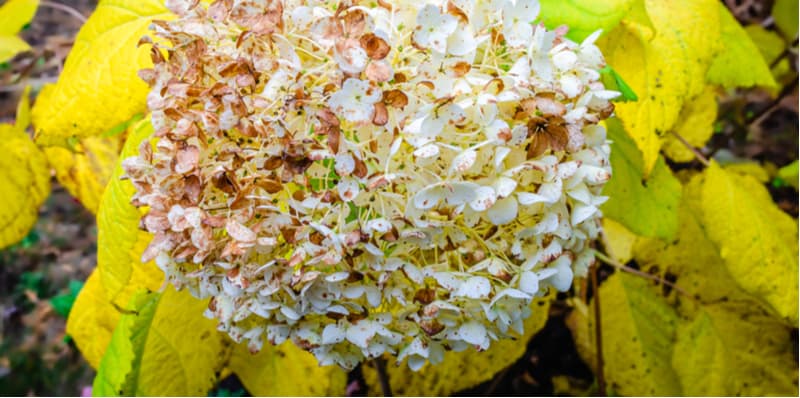The Ultimate Guide To Hydrangea Leaves Turning Yellow
Table of ContentsHydrangea Leaves Turning Yellow - The FactsHydrangea Leaves Turning Yellow Can Be Fun For Everyone9 Easy Facts About Hydrangea Leaves Turning Yellow ExplainedMore About Hydrangea Leaves Turning YellowRumored Buzz on Hydrangea Leaves Turning YellowHydrangea Leaves Turning Yellow for Dummies
One possibility is that the plant is not getting enough sunlight. Throughout the winter season, the days are shorter, and the sun is not as extreme, so make certain to position your Hydrangea in a place where it will get at least six hours of sunlight every day. Another reason for Hydrangea yellow fallen leaves in wintertime might be excessive water.The leaves could be turning yellow due to temperature stress. Hydrangeas like cooler temperature levels, so if the plant remains in a spot that obtains as well hot or also chilly, the leaves will certainly transform yellow. If you think temperature level anxiety could be the issue, attempt moving your Hydrangea to a various place or safeguarding it from the elements with a cloth wrap.
New development will be observed in early springtime, when you'll discover environment-friendly foliage sprouting from stems that may have appeared dead. Nonetheless, if your leaves are transforming brown in springtime or summer season, there are likely various other elements at play. The specific factors depend on the selection and their expanding conditions, yet generally, brownish hydrangea fallen leaves suggest dehydration and wilting in the warmth
Not known Incorrect Statements About Hydrangea Leaves Turning Yellow

Wilting is brought on by lack of wetness, meaning there are a few excellent methods to use to stop this from taking place. Give your hydrangeas a healthy glug of water every couple of days when the temperature levels are climbing up high, and treat the soil to much better preserve dampness. After watering, a dab of mulch around the base of each plant ought to assist with this by maintaining dampness in the soil.
This disrupts fungi spores from clearing up. "The Botrytis fungi thrives in great and damp problems, so stay clear of showering the whole plant when watering and just water at the roots," shares Roy Nicol, learn this here now a Master Horticulturist. If you've missed the chance for prevention and are handling an infection you must eliminate all dead or drastically contaminated fallen leaves from the plant and damage them to avoid further spread.
Excitement About Hydrangea Leaves Turning Yellow
As a basic general rule, we suggest eliminating leaves when they are 50% brown or greater. While browning triggered by any reason can't be turned around, taking the restorative action described above will certainly urge the plant to grow brand-new fallen leaves so the damaged leaves either fall off normally or can be gotten rid of by the garden enthusiast.
Hydrangeas must be sprinkled only when the leading couple of inches of soil are completely dry, and ought to be offered a comprehensive soaking each time. Underwatered hydrangeas are most likely to have yellow, wilting, and drooping leaves.
The method you fix hydrangea leaves transforming yellow relies on the key issue causing the yellow fallen leaves. This can be tough to figure out, yet once you do you will certainly be able to change your plant treatment accordingly to deal with the problem. As discussed before, a common concern with hydrangeas is nutrient shortages.
Hydrangea Leaves Turning Yellow Fundamentals Explained
Throughout the height expanding season, you should sprinkle at a price of about 1 inch weekly. If you are fretted about not correctly sprinkling your hydrangeas, important site there are a number of things you can do. Adding mulch to the base of the plants over the origin area assistance to control the temperature around the shrub and keep water in the dirt.
You can purchase and install easy watering worlds. Sprinkling globes hold water in them and gradually launch this water into the dirt as the ground comes to be completely dry. Simply fill up the globe with water, stick the spout into the dirt within the root zone near more information the base of the plant, and leave it in position until all the water is gone.
If it is too extreme, some plants will certainly never recoup from transplant shock and will certainly proceed to decrease up until they pass away. Decrease transplant shock by consisting of as several origins as possible when digging up your plant to relocate. Make certain to offer even more water than normal in the weeks following planting to help your plant recuperate and expand new origins.
Hydrangea Leaves Turning Yellow for Dummies
To stay clear of spreading out fungal conditions, be sure to thouroughly tidy and decontaminate any type of trimming devices before and after usage. You can try to purge the origins with water to eliminate excess fertlizer.
Your hydrangea plant prefers well-drained, wet soil. If the pot has poor water drainage, or your dirt is flooded, the leaves will start to transform yellow.
If you don't sprinkle your hydrangea plant for more than a week, the fallen leaves will begin transforming yellow. Fungal conditions that attack the plants tend to show join the origins and the fallen leaves of the plant. Among these conditions is origin rot, that makes it hard for the plant to feed correctly.
Excitement About Hydrangea Leaves Turning Yellow
